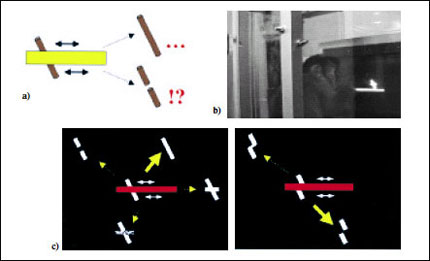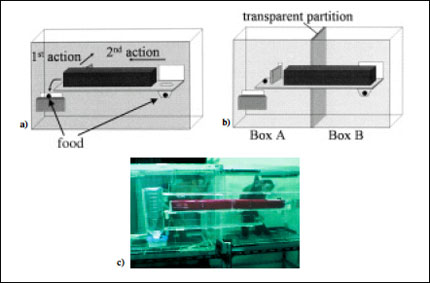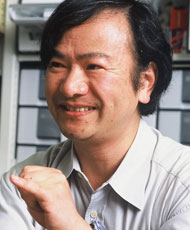Exploring minds of nonhuman relatives
Our interfaculty group of psychologists in Kyoto University was selected as one of the 21st Century Center-of-Excellence Programs in 2002. This group, named Kyoto University Psychology Union, aims at comprehensive understanding of mental functions by integrating experimental, field, and clinical approaches to the mind.
We are working on the four major questions regarding the mind: namely, what are the nature and functions of mental images and representations, how do the body and the mind interrelate, how does the mind interact with social and cultural milieu, and how does the mind change in time? I myself have studied cognitive processes of nonhuman animals to answer the last question from an evolutionary point of view.
Drawing a picture of how the mind has evolved is not an easy task. Because minds do not leave their shape as fossils, a direct sketch is of course impossible without a time machine, except in such lucky cases where the mental functions of our ancestors left outcomes like tools and painting. However, we are able to infer the evolutionary process of the mind by exploring the minds of our current nonhuman relatives. This academic field is called comparative cognitive science or comparative cognition.
The specific question my colleagues and I ask is how nonhuman animals recognize objects and events that are not directly detected by sensory organs. It is a good idea to compare recognition of such invisible objects and events across species because the characteristics of a perceptual system should be most evident when the system receives incomplete and ambiguous information.
One such case in point is referred to as perceptual completion. For example, we recognize the complete clock tower when we look up at it through the camphor tree, though what we actually sense is a collection of visual fragments through the leaves and twigs. Humans routinely complete hidden portions of partly occluded objects.
A laboratory version of perceptual completion is shown in Figure 1a. When human infants see the two rods moving in concert behind the occluding belt, they recognize the rods as unitary. The infants are in fact surprised if they are shown two separate rods without the occluding belt after they become bored seeing the rods behind the occluder many times.

Figure 1. a) An example of perceptual completion. Human infants are surprised at the broken rods after being habituated to the rods moving behind the occluder. b) A tufted capuchin monkey working on the matching task on the computer screen. c) Capuchin monkeys tend to match the straight rod to the sample on the left and broken rods to that on the right. How the monkeys complete occluded portion is like humans.
Using a computer display we trained nonhuman animals to match a unitary rod and a pair of broken rods; they were trained to choose the same comparison stimuli as the sample. Then we tested which type of stimuli they choose as a matching comparison when they are presented the non-distinguishable sample having its critical central portion occluded by a surface.
A language-trained chimpanzee and three tufted capuchin monkeys overwhelmingly chose the unitary rod when the non-distinguishable sample was presented. Thus they clearly complete the occluded portion like humans. In later experiments the capuchin monkeys were shown to share most of the rules of how to complete the hidden parts with humans (Figures 2b and 2c).

Figure 2. a) A tandem test box in which individual capuchin monkeys learned the whole two-action sequence to obtain rewards. b) The separated tandem box used to test whether the monkeys in Box A and Box B spontaneously cooperate by dividing the action sequence between the two. c) Two capuchin monkeys performing the cooperation task. The monkey in Box A is waiting for the second action by the monkey in Box B.
However, pigeons tested in the same procedure chose the pair of broken rods. This choice was maintained when we modified the shape of the occluding surface to an undulated one so that the top and the bottom portion of the rod changed in shape and size as the rod moved along the surface. Pigeons do not seem to complete occluded contours. Actually the data were consistently negative although we have tried many other situations including photos of food as stimuli.
Pigeons are known to perform extraordinarily well in a variety of cognitive tasks such as concept-formation, memory, image processing, and insightful problem solving. They are highly cognitive but seem to perceive the environment very differently from humans. We humans are apt to think that the way we perceive the world is the single ultimate solution to recognize the environment. This notion is simply wrong. Perceptual systems seem to have evolved diversely even among species having well-developed central nervous systems, probably to fit the way the species live.
The second topic we tackled was how nonhuman animals recognize others' mental states. Mental states are another set of events not detectible by the sensory organs. This social intelligence to "read" others' minds has been suggested as a clue to understanding how physical intelligence such as tool use and logical thinking has evolved.
We tested whether capuchin monkeys spontaneously deceive conspecific opponents. Two food boxes were placed between a dominant monkey and a subordinate monkey. Only one of the boxes contained food. The subordinate monkey was able to see the contents of the boxes and to open them. The dominant monkey was unable to do either, but was able to usurp the food once the box was opened.
Two of the four subordinate monkeys started to open the empty box first in more than 10% of the trials. It is hard to conclude whether this behavior incorporated deceptive intention or not. However, it is evident that capuchin monkeys have the intelligence to adjust their behavior in response to social situation in which misleading others could benefit themselves.
We also discovered that this species spontaneously cooperate by dividing labor between two monkeys. We first trained each individual monkey to perform a two-action sequence to obtain two rewards in a tandem cage (Figure 2a). Then we separated the cage into two areas and two monkeys were simultaneously put into each area (Figure 2b). Now the two monkeys had to divide the action sequence between themselves.
All of the three pairs started to cooperate without explicit training (Figure 2c). In one of the tests that followed we placed only one reward at a time so that one of the workers never obtained the food. When the placement of the monkey was switched every one or three trials, the monkeys maintained this cooperative behavior. Thus they not only solved a cooperative task spontaneously but also showed reciprocal altruism.
These results led us to think that a variety of social intelligence humans exhibit in both competitive and cooperative situations may have their roots in the common ancestor of humans and New World monkeys that lived about 30 million years ago.
A brief look at nonhuman animal studies such as the above tells us that human perception and cognition are both evolutionarily continuous to and ecologically different from those of our relatives. Such diversity among relatives must be the most important thing for the symbiotic ecosystem the earth has fostered. All the lives share the same evolutionary time of nearly 4 billion years.

Kazuo Fujita
Born in 1953.
Specialized Research Field: Psychology, Comparative Cognition
Graduate of doctoral program, Graduate School of Science, Kyoto University
D.Sci., Kyoto University
Professor, Graduate School of Letters, Kyoto University
URL 藤田のホームページ (External Link) (Japanese only)
"Being with nonhuman animals makes me happy. Take chimpanzees. They're closely related to humans, which makes it fairly easy to understand what they're thinking. I can also empathize with them to some extent."
Prof. Fujita has kept a wide variety of nonhuman animals in his life, ever since he was a small child. Hence, it seemed only natural that he should go into science, specifically, animal ecology. What is surprising is that he went on to become a professor at the graduate school of letters. Yet, his unraveling of the "behavior" of animals, including human beings, progressed dramatically, spreading into all manner of disciplines. Kyoto University is an ideal research environment for this, with scientists all over the place, studying all kinds of subjects.

Prof. Fujita believes that psychology needs to expand the scope of its research subjects to encompass the diversity of psyches. He describes

